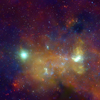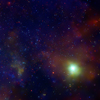CXC Home | Search | Help | Image Use Policy | Latest Images | Privacy | Accessibility | Glossary | Q&A
Chandra Mosaic of Galactic Center
Quicktime MPEG
A new panorama of the Milky Way's center reveals thousands of point-like sources, mysterious filaments, and a diffuse haze, all in X-ray light. This motion graphic highlights various features of this mosaic, which extends some 900 light years across. Because X-rays penetrate the gas and dust that blocks optical light coming from the center of the galaxy, Chandra is a powerful tool for studying the Galactic Center. This image combines low-energy (red), intermediate energy X-rays (green) and high-energy X-rays (blue) that Chandra can detect.
[Runtime: 00:50]
Quicktime MPEG
A new panorama of the Milky Way's center reveals thousands of point-like sources, mysterious filaments, and a diffuse haze, all in X-ray light. This motion graphic highlights various features of this mosaic, which extends some 900 light years across. Because X-rays penetrate the gas and dust that blocks optical light coming from the center of the galaxy, Chandra is a powerful tool for studying the Galactic Center. This image combines low-energy (red), intermediate energy X-rays (green) and high-energy X-rays (blue) that Chandra can detect.
[Runtime: 00:50]
(Credit: NASA/CXC/UMass/D. Wang et al.)
Tour of Galactic Center
Quicktime MPEG
This image from the Chandra X-ray Observatory reveals a wealth of exotic objects and high-energy features at the center of our Milky Way galaxy. In this new and deep image from Chandra, red represents lower-energy X-rays, green shows the medium range, and blue indicates the higher-energy X-rays Chandra can detect. The hundreds of small dots show emission from material around black holes and other dense stellar objects like neutron stars. A supermassive black hole -- some four million times more massive than the Sun -- resides within the bright region to the right of center. The diffuse X-ray light comes from gas heated to millions of degrees by outflows from the supermassive black hole, winds from giant stars, and stellar explosions.
[Runtime: 00:50]
Quicktime MPEG
This image from the Chandra X-ray Observatory reveals a wealth of exotic objects and high-energy features at the center of our Milky Way galaxy. In this new and deep image from Chandra, red represents lower-energy X-rays, green shows the medium range, and blue indicates the higher-energy X-rays Chandra can detect. The hundreds of small dots show emission from material around black holes and other dense stellar objects like neutron stars. A supermassive black hole -- some four million times more massive than the Sun -- resides within the bright region to the right of center. The diffuse X-ray light comes from gas heated to millions of degrees by outflows from the supermassive black hole, winds from giant stars, and stellar explosions.
[Runtime: 00:50]
(Credit: NASA/CXC/UMass/D. Wang et al.)
Return to Galactic Center (September 22, 2009)




